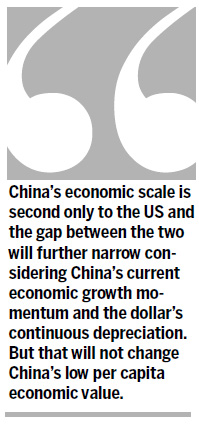
Huge economic and social security gap between urban and rural areas serves as important indicator of China's status
Despite the remarkable economic and social development it has achieved since reform and opening-up in 1978, China is still a developing nation, as indicated by both its per capita economic indices and its economic and social structure.
It is necessary to take into account a country's economic aggregate and its per capita output to accurately measure its real economic and social development levels. After more than six decades of rapid development since the founding of new China in 1949, China's gross domestic product (GDP) totaled $5.9 trillion in 2010, the world's second largest.
However, China's per capita output lags far behind developed countries. Statistics from the World Bank indicate that China's per capita GDP was only $3,744 in 2009, less than half the world's average of $8,598. It was less than one-tenth that of the United States, Japan and some other developed economies. The country's per capita consumption was $1,306 the same year, far below the world's $5,093 average and 4.0 percent that of the US and 5.5 percent of Japan.
In striking contrast to the balanced development in developed countries, China's economic development is unevenly distributed between urban and rural areas and among different regions. Its per capita disposable income and consumption outlay among rural residents, for instance, are less than one-third that of their urban counterparts. Compared with urban areas, a large number of rural residents are not covered by the country's pension network and their healthcare expenditure is also much lower than that of urban residents.
China's consumption of luxury articles has grown rapidly in recent years, which has been cited by some Westerners as showing China is a developed country. However, instead of being a symbol of its full prosperity, the growth of luxury consumption is supportive evidence of China's widening gap between the rich and poor. By 2009, the country still had 36 million people living in poverty according its own criteria. If calculated in line with the United Nations' standard the poverty-stricken population swells to 150 million and larger still under the criteria applied by developed countries.
The country's status as the world's largest exporter has also caused some people to overestimate China's position in the international labor division system. One of the important reasons why China has developed so rapidly into the world's largest exporter is its active participation in the global and East Asian manufacturing network.